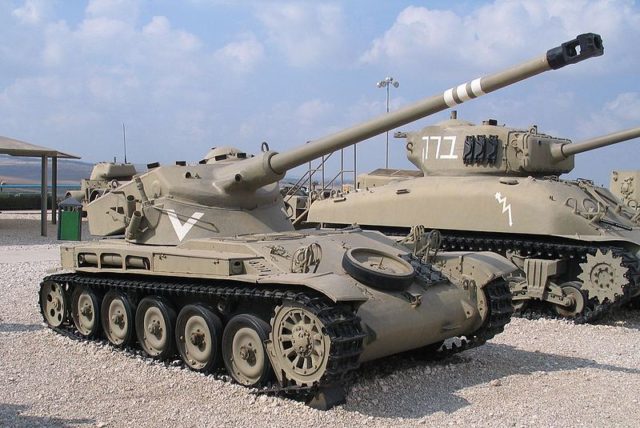Following the fall of France in 1940, the country’s development of armored vehicles was suspended for a period that lasted throughout WWII.
France probably had the best tank designs in Europe before the War, but it was reduced to the puppet state of Vichy France after occupation by the Germans.
As the war ended, the French military felt the need to continue its pre-war tradition of tank designs and immediately started the development of several models.

In 1946 they produced a preliminary drawing of the Char 13t-75 Modèle 51, or what would later be known as the AMX 13 tank.
Its name derived from its original weight which was 13 tons. Probably the most innovative part of the tank is its oscillating turret made of two hinged parts to which the gun is fixed, and the entire upper turret changes elevation.
This provides high gun placement, smaller turret size and simpler fitting of an autoloader. The AMX 13 employed a loading system fed by two six-round magazines.
On the other hand, the autoloader system proved to be unreliable, which led to the unpopularity of the design.

The AMX 13 was intended as a light tank suitable for air transport, as its role was to serve as a fire support vehicle for paratroopers.
In 1948 a first prototype was running, and in 1953, the tank entered production. Armed with a 75 mm gun, a machine gun, and smoke grenade dischargers, it was intended to provide immediate cover after airborne insurgency.
It had light armor (10-40 mm thick) which was designed to reduce the weight of the tank and improve its speed and mobility. The AMX tank was capable of developing a speed of 37 mph (60 km/h).

It was established as the light tank of the French Army. The AMX 13 went on to produce more than a hundred different variants, some of them included self-propelled guns, anti-aircraft systems, APCs, and ATGM versions.
The tank was tested in action during the Suez Canal Crisis in 1956 as part of the 2nd Foreign Cavalry Regiment.
It also participated in some operations during the Algerian War for Independence, but due to the nature of the conflict – in which the Algerians used extensive guerilla methods – the tank found itself of little use.

It was exported to other countries, such as Israel, Austria, Belgium, Chile, Pakistan, and many others. During the Six Day War, 400 AMX tanks were part of the IDF (Israel Defense Force) armored units.
It became evident the tank was too lightly armored and armed to perform any other purpose apart from support and reconnaissance.
The tank also performed poorly as part of the Pakistani arsenal during the Indo-Pakistani War of 1965, which cemented its reputation as no match for the main battle tanks of the time.
Nevertheless, the AMX 13 has been modernized numerous times and continues to serve in the armies of 11 countries which include Argentina, Cambodia, Ivory Coast, Djibouti, Nepal, Ecuador, Indonesia, Kuwait, Mexico, Peru, and Venezuela.
